Can you find the cat hidden on this image?
It’s not easy…
Scroll down to find the answer…
a bit more…
Via: www.reddit.com/r/pics/comments/4p517i/when_you_see_it
Would you like to know more about cats? Check our Feline Courses:
Can you find the cat hidden on this image?
It’s not easy…
Scroll down to find the answer…
a bit more…
Via: www.reddit.com/r/pics/comments/4p517i/when_you_see_it
Would you like to know more about cats? Check our Feline Courses:
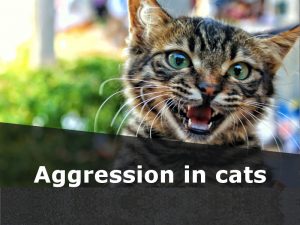
Cats may show aggression for different reasons and it’s important to identify them in order to properly manage the problem. Cats may show aggression towards humans out of fear, maybe due to poor socialisation with humans or due to an unpleasant event associated with that person or with people in general. Cats, just like any other animal, can also be aggressive when they are in pain.
General signs of aggressive behaviour include putting the ears back, having the body and tail lowered, having the fur up, dilated pupils (the dark part of a cat’s eyes), growling and attacking either using their claws or using their teeth. If your cat is being aggressive because he or she is scared of a person, your pet may also avoid that person and try to hide. If your cat is scared and he or she is approached or cornered, your pet may feel threatened and attack.
Ongoing exposure to fear inducing situations may worsen the aggression and you may notice stress related signs, such as avoidance behaviour, decreased appetite and over grooming. It’s important to manage this problem and as with all behaviour problems, a vet should check the cat’s health to make sure these issues are not motivated by pain or illness.
After you exclude medical causes, you can try to gradually expose the cat to the person he or she is scared of. Start by keeping them both apart but close enough for the cat to see him or her. When the cat seems comfortable with that and does not show any signs of anxiety or stress the person can move a bit closer. Repeat the process having the person move closer and closer, as your pet becomes accustomed and relaxed in his or her presence. You can reward your cat with a tasty treat as he or she relaxes and doesn’t react fearfully or aggressively around the person in question. You can repeat the process, with the person moving closer each time, and gradually the cat learns to associate this person’s presence with a positive, stress-free experience.
If your cat is showing aggression towards people and if you have any questions at all, do not hesitate and bring your pet to the vet. Your vet can give your pet a check-up to exclude any medical conditions that may be causing this inconvenient situation, and if you are dealing with a behavioural issue, you vet can either help you manage this situation or recommend a cat behaviourist that can help!
Would you like to know more about cats? Check our Feline Courses:
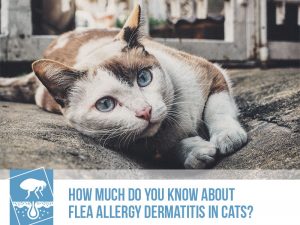
With the temperatures rising the risk of our pets becoming infested by parasites such as ticks and fleas increases tremendously, since these small creatures thrive on warm weather. Fleas can be a real nightmare for pets and for their owners. These parasites will feed on our pet’s blood causing irritation, itching and a lot of discomfort.
The problems caused by fleas go beyond itching since they are also vehicles for the transmission of other parasites such as tapeworms and diseases such as cat scratch disease. Unfortunately, some of our pets can also have the added hassle of being extra sensitive to flea bites and suffer from flea allergy dermatitis.
Flea allergy dermatitis is a hypersensitivity reaction caused by proteins (antigens) present in the flea’s saliva. Cats suffering from this condition show an exaggerated reaction to flea bites that leads to severe itching, over-grooming and even damage to their skin. All cats can be affected regardless of their age or breed.
It takes just one flea to cause severe itching in pets susceptible to flea allergy dermatitis and the best way to prevent this problem is to keep a regular and effective flea treatment plan.
To check your cat for fleas spread your pet’s fur with your fingers, especially on the base of their tale. It is not always possible to see the fleas running around but if you look closely you will probably find their faeces. Look for small black specs located close to the skin.
If you notice your cat is itching more than usual or grooming excessively to the point of damaging fur and skin take your pet to the vet. These clinical signs can be caused by flea allergy dermatitis but other conditions can present similar signs.
It is also very important to remind owners to never user dog tick/flea treatment products on cats! Many of these products contain substances which are highly toxic for cats and are meant to be used only in dogs. Follow you vet’s recommendation and always check product labels.
Would you like to know more about cats? Check our Feline Courses:
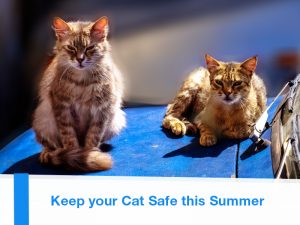
During the summer months, there are many hazards you should be aware of in order to keep your furry feline friend safe.
Just like dogs, cats can suffer heat stroke when exposed to hot temperatures, even if he or she lives indoors. Your cat should always have access to cool water, which should be available at different places throughout the house, particularly in the areas your cat spends more time at. If your cat has outdoors access place water bowls in shady areas to keep the water temperature more comfortable. Don’t forget to frequently check the water level and wash the bowls daily. You can also use cat drinking fountains to induce your cat to drink more water or add ice cubs to the water bowls.
Your cat should have access to shaded areas to stay cool at all times. Make sure there is a cool place in your house your cat can go to.
Do not leave your cat locked in a parked car. Even a few minutes in a car, which can be located in a shaded area with the windows opened, can be deadly for your cat.
Young, older, obese and sick cats are more likely to suffer heat stroke. Signs of heat stroke in cats include restlessness, panting excessively and drooling.
It is also recommended to apply pet sunscreen to your cat’s ears and nose, particularly if he or she is light coloured, as being so makes pets more susceptible to sunburns. Just like what happens with people, sunburns can lead to cancer.
Grass seeds can also be dangerous as they can get caught in your cat’s paws, eyes or ears and need to be removed. Your pet may show signs of discomfort and shake his or her head.
In warmer months there are also more external parasites such as flea and ticks so make sure you use a safe and effective flea/tick control product on your cat. Please remember to never use a flea/tick dog treatment on your cat.
Bee stings are also more common during this time of the year and they can be really dangerous if the cat is allergic, if he or she is stung many times or if he or she is stung near the mouth or in the throat. This could lead to swelling of the airway and restrict breathing. If your cat has been stung by a bee take him or her to the vet!
Keep our tips in mind and enjoy a nice and safe summer with your cat!
Would you like to know more about cats? Check our Feline Courses:
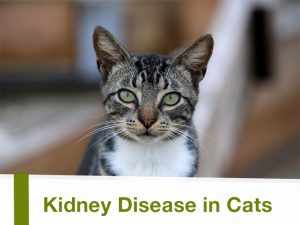
Just like us, cats have two kidneys and their main role is to filter the bloodstream and remove waste products produced by the body’s metabolism. These waste products are eliminated from the body in the urine. The kidneys also help to regulate the volume and composition of the blood.
Kidney disease is one of the most common problems in cats. This condition leads to the accumulation of toxic waste in the bloodstream, making the animal ill and perpetuating the kidney damage. Kidney disease can be acute or chronic. Acute kidney disease is a severe condition with a relatively sudden onset, most often days, in which the kidneys are suddenly unable to function properly, whereas chronic kidney disease is a disease that has been developing over the course of a longer period of time. The most common causes of acute kidney disease are the ingestion of toxic substances, like antifreeze, certain human medications and certain foods.
Chronic kidney disease is one of the most common conditions affecting older cats, from 7 years of age onwards. Two thirds or more of total kidney function must be lost before most cats show signs of disease. It is an ongoing, irreversible process that progresses over time.
Signs of chronic kidney disease include weight loss, poor appetite, lethargy, increased thirst and increased urination. As this disease advances, other signs may appear, such as sores in the mouth and bad breath produced by toxic levels of waste products, as well as vomiting and diarrhoea. If you notice these signs on your cat do not hesitate and take your pet to the vet!
Given prompt treatment acute kidney disease may be reversible. Unfortunately, chronic kidney disease cannot be reversed, but it can be managed, both increasing the quality of life of affected cats and potentially slowing down the progression of the disease.
Would you like to know more about cats? Check our Feline Courses:

Cats that live indoors need properly enriched environments to live a happy life. The purpose of environmental enrichment is to offer options so that the cat can express his natural behaviour. If this isn’t provided your cat may feel stressed which can affect both his health and behaviour.
Indoor cats need unrestricted access to resting areas where stress factors, such as loud noises and other animals, can be minimized. In this place the cat should have access to a litter box, food, water, a scratching post, a perch and toys.
Litter boxes should be located in a safe, quieter area, away from food and water bowls. If you have more than one cat a box should be provided for each cat. The litter box should be scooped daily and washed weekly.
Small portions of food and treats should be given at random times throughout the day and in various places around the house. This seems to be fun for most cats, allowing them to display some hunting behaviour. You can also use food dispensing toys. Cat drinking fountains can also provide an interesting addition to the environment for some cats.
Cats also need perching options throughout the household, as they naturally climb for observation and safety, so provide places to climb and look out of windows.
Scratching is a natural behaviour for cats. Scratching posts should be placed in frequently visited areas of the home and in proximity to preferred resting places. Cats that scratch chair legs may prefer a vertical scratching post, while cats that scratch rugs and carpets may prefer a horizontal scratching post.
Play behaviours in cats are closely related to their natural hunting behaviour. Appropriate toys for cats include wand toys, self-propelling toys that mimic prey, balls inside a box, catnip filled toys and light beam pointer games. Toys should be rotated at least once a week to maintain novelty and interest.
Other enrichments that can be offered include music, catnip or grasses and playtime with other cats. Boxes are another way of keeping cats entertained and comfortable. They use them to keep warm, to escape threats and to scratch and perch on. Your time with your cat is also important, so make sure you have daily time to interact with your pet.
Cats kept solely indoors should be provided with ways to exhibit their natural behaviour to ensure their welfare!
Would you like to know more about cats? Check our Feline Courses:
An increase in pet ownership combined with longer working hours, means more and more people are relying on pet care professionals to help look after their beloved four legged friends. And when leaving your pet in the care of another you want to be sure they are trustworthy, reliable and ultimately covered should anything go wrong. Therefore, it is important when vetting any potential pet care service professional that you check they have adequate insurance cover in place. You wouldn’t leave a child with someone who wasn’t properly insured to do so and the same can be said for the pet care world.
Whether it be dog walking, pet sitting, pet grooming, dog training or another pet care service, each business should have a pet business insurance policy in place. In short, this will ensure they are covered should injury or damage occur which is deemed to be their fault whilst your pet is in their care. Having this insurance in place gives owners the peace of mind that their pet is going to get the best care whilst with the pet professional. The danger of leaving your pet with someone who does not have adequate pet business insurance is that if something was to go wrong, and your pet was injured or hurt, you may not be able to get the compensation you deserve.
Having specialist pet business insurance cover also shows that the business is professional and values its customers. Most pet businesses will display a badge on their website to show that they are fully covered. Pet business insurance companies including Protectivity Insurance will often include these badges as standard, as part of their pet business insurance policy. This means the pet service professionals customers are able to click on this badge and view the insurance certificate. If you cannot find anything like this on a pet business’s website, then ask! If they are covered they will be more than happy to show you their insurance certificate.
When searching for a pet care professional the more research you do the better prepared you will be to find the right one for you and your pet. There are many other factors to consider including how well they get on with your pet, location, price, recommendations, reviews and although pet business insurance is just one of these elements to tick off the list it is important to check to give you peace of mind when leaving your pet with them.
Author: Protectivity Insurance
http://www.protectivity.com/product/pet-business-insurance/
Would you like to know more about cats and dogs? Check our Feline and Canine Courses:
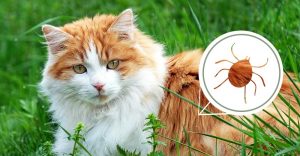
Parasites are organisms that feed on other animals (hosts). Besides causing health issues to their hosts some of them can also transmit diseases. It is important to control parasites in your cat not only for his health but also for yours, since many of them can also affect humans. Factors influencing the prevalence of the different parasites on your cat include your cat’s age, having outdoors access, living with other pets, time of the year and where you live. Owners should be aware that even indoor cats need parasite prevention.
External parasites are found in the hair and skin of cats. The most common ones include fleas, mites and ticks.
All cats are at risk of getting fleas. Fleas will not only cause skin irritation but may also transmit diseases. It is important to know that adult fleas live on the pet’s body but all the other life stages of the flea are spent in the environment. For this reason, if your cat is infested it is recommended to treat not only your cat but also to kill the fleas that may have started developing in your house. Despite thriving in warm temperatures and high humidity, these parasites are active all year. The comfort of our modern heating systems will also contribute to their development in our homes during colder months.
Mites cause irritation of the skin, resulting in itching, hair loss, and inflammation. Mites are common parasites of cats, especially ear mites. These parasites cause significant inflammation and pain and can lead to bacterial infections. If your cat is infested you may notice regular shaking of the head, constant itching of the ears and smelly and dirty ears.
Ticks vary in type and distribution depending on where you live. These parasites wait on tall grass for a host to pass nearby, since they can only crawl and cannot fly or jump. Ticks cause skin irritation and can transmit serious diseases, that threaten your cat’s health.
On the other hand, internal parasites live in your cat’s internal organs. There are two major types of internal parasites that can often affect cats: roundworms and tapeworms.
Cats can acquire roundworms via several routes so even indoor cats are at risk. A large number of roundworms infesting a growing kitten can affect the kitten’s growth, cause serious digestive upsets and be life threatening. Heavily infested kittens have a characteristic increased belly.
Several types of tapeworms may infect cats. These can be acquired through fleas or when cats hunt and eat prey. An infestation can cause vomiting or weight loss.
If your cat is infested with worms you may notice: diarrhoea, visible worms in stool, bloody stool, round appearance of the abdomen, weight loss, vomiting, constipation, itchy bottom or even trouble breathing.
Outdoor cats are particularly prone to get infected by parasites (external and internal) but indoor cats can also get them. Cats that do not receive regular preventive health care are most at risk for developing complications associated with parasites.
There are many different treatments that can protect your pet from internal and external parasites and your vet will be able to advise you on the best product for your pet’s specific case and also the treatment schedule that better suits him or her.
Would you like to know more about cats? Check our Feline Courses:
Whether it’s working alongside a resident pet or bringing in your own, a furry creature can be a welcome addition to an office. In Britain we love our pets and over half of us have said we’d happily take them into work if we could.
To find out what having an office pet entails, Lilli Hender from OfficeGenie.co.uk provides an insight into the trend and discusses the possible advantages and disadvantages.
Pets glorious pets
For some workplaces having an in-house pet is nothing new, but for the majority of people, sharing their office with an animal companion is yet to happen. The phenomenon has proved popular in the news and it seems more and more companies are wanting a slice of office-pet action.
Perhaps most notably the transport service Uber has provided deliveries of kittens and puppies to workplaces across America. HR firms have begun to introduce ‘peternity leave’: time to settle new pets; comfort sick pets; and bereave lost pets. In addition to this, another business recently made headlines for allowing every day to be a ‘bring your pet to work’ day.
Is it good news for employees and employers?
The answer, unsurprisingly, is yes. Pets have been shown to lower workplace stress and boost employee morale and productivity. They also improve bonding between staff members and clients by giving the place a family feel.
It’s worth noting that not everyone responds well to animals, some people have allergies and some people have phobias. Business owners should check all staff members would be on board before interviewing a prospective pup. It’s important to take into consideration the additional finances, such as food and veterinary bills, and what happens with the pet after office hours.
Is it good news for pets?
Almost all of the data and commentary on the phenomenon is from the perspective of the employees rather than the animals. However, there are more than a few factors that will affect how the pet takes to their new life in the office: including (but not limited to) their personality, their size, and their age.
Measures should be taken to ensure the move is as stress and danger free as possible. Uber, for example, had representatives from the cat shelters visit the offices before hand to check they were suitable for the kittens. Support is out there: Cesar’s Way has a guide to introducing a dog into the workplace and in the UK The Health Insurance Group have teamed up with clinical pet behaviourists to create a wellbeing programme for office pets.
Deciding upon your furry companion
When it comes to the best office pet, most business owners opt for a dog. Caring for a canine is usually familiar territory which makes for an easier adjustment period. Many breeds will be more than suitable but here are five of the best:
It might be a while before pets in the workplace are the norm but it’s something to look forward to in the meantime. As long as both parties are happy, having an office pet can be a brilliant decision for all involved.
AUTHOR BIO
Lilli Hender works for Office Genie: a desk and office space marketplace. She writes about office life and the latest workplace trends.
References for dog breed characteristics:
http://www.animalplanet.com/pets/10-best-small-dog-breeds-for-therapy-work/
Would you like to know more about cats and dogs? Check our Feline and Canine Courses:
Statistics show that indoor cats have longer, healthier lives than outdoor cats and in fact keeping your cat indoors may reduce some risks. However, these cats are also more likely to develop behavioural problems than those allowed outside if their environment isn’t properly enriched. The decision to keep your cat inside or allow him or her to go outside is a personal one and much will depend on your circumstances and on the personality of the individual cat.
Knowing the benefits and disadvantages of keeping your cat indoors or outdoors will help you decide what is best for your cat. Here are some factors you should keep in mind when making this important decision:
Cats kept solely indoors should be provided with ways to exhibit their natural behaviour to ensure their welfare and avoid undesirable behavioural issues. Your cat needs to have enough space to exercise, climb and play indoors. He or she should also have a variety of resting places.
Some cats love going outside and others don’t want to go out at all, so wherever your cats spend their time, make sure they’re safe and happy!
Would you like to know more about cats? Check our Feline Courses: